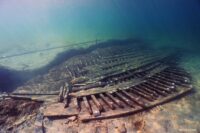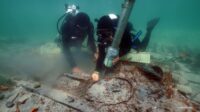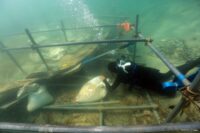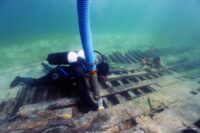
Discovered 300 feet from the shore at a depth of just six feet, the ship was dubbed Marausa 2 because it is very similar to a wreck from the same period discovered a third of a mile away in 1999. That wreck and its cargo of stoppered amphorae containing dried fruit was recovered in 2011 and was exhibited at the Museo Archeologico Baglio Anselmi in Marsala.

The condition of the timbers made it possible for the entire ship to be raised whole. The recovery works began this June, overseen by the Superintendency of the Sea for the region of Sicily. First underwater archaeologists documented and excavated the site. Then they removed all the loose materials and cargo. They used vacuuming equipment to clear as much sediment as possible.

The wrapped and caged wreck was then tugged by modern ships 20 miles or so along the coast to the port of Marsala where it spent the night of October 3rd on the pier. The next day it was transported by road to the Museo Archeologico Baglio Anselmi where it was immersed in a fresh water pool. Once the process of desalination is complete and the wood stabilized, it will be moved the museum’s laboratory for consolidation and restoration.

This video from the Superintendency of the Sea shows the wreck site in all its glory, the surviving timbers, the thick layers of amphorae, how every one the artifacts recovered were labeled by hand, the vacuuming of the sand and the emergence of the hull as the cargo was removed.
* This article was originally published here






No comments:
Post a Comment